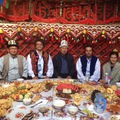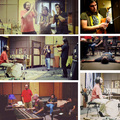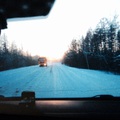Ezt a bejegyzést elsősorban azoknak ajánlom, akik tudnak oroszul és jó a szemük, így könnyen elboldogulnak a picinyke cirill betűk világában. Na jó, angolul is itt van a fordítás. Magyarul talán egyszer majd itt lesz, de egyáltalán nem biztos. A google translator egészen tűrhetően elboldogul a szöveggel, ha kell.
So, this is an article about our band, Madjayar in the biggest Yakut journal magazin, Zhurfix. The English version is much richer, more extended then the Russian. The text had to compressed to needs of the magazin. The interview is made by Elena Shishigina.

(Zhurfix) So Aron, as far as we know, u have n instrument just like Khomus which is called doromb in Hungary but it is not as popular. So how did u "meet" the jews harp?
(Áron Szilágyi) In Hungary the "Doromb" as our traditional instrument. I wouldn't say that is not popular, may not as much as khomus in Yakutia, but people are getting to know it more and more. In our country we have many different traditional instruments and a very rich musical tradition. Jew's harp is a small part of this big tradition. My father, Zoltán Szilágyi started to make Jew's harps in the late 70's and since then he has become one of the most known Western makers in the world, so I was born into it. I was 3 when I learned how to play it and since I was 18 I have been traveling around the world giving workshops and concerts either solo or with my bands.
So your father is the only one in Hungary who makes doromb. Did u have a chance to meet any of our craftsmen?
Yes, my father is the only maker in Hungary who professionally handcrafts dorombs, he makes more than 100 different types of Jew's harps. Since 1998 I have participated every International Jew's Harp Festival. I also have been involved in the program committee in 2006 in Amsterdam, I was the head organizer of the 2010 one in Kecskemét, took part in the program selection in Yakutsk in 2011 and in Taucha in 2014 as well. At these wonderful events I had the chance to meet the genius Yakut khomus maker masters. I was really astonished by the fine work and the quality of the sound their instruments represent. These instruments perfectly suitable for the traditional Yakut khomus music, wonderfully rich of overtones.

When did you first hear about Yakutia?
The first time I heard of Yakutia was when the legendary Jew's harp expert, professor Frederic Crane visited our family in 1991. He gave a Yakut khomus as a gift to my father. That was the first time when I heard of your land and saw and tried a Khomus. It was really interesting to try out a Jew's harp with such a strong spring and strange shape. It was shaking my head, I couldn't image how the Yakuts were able to play that instrument for hours. At that time it was beyond my imagination that one day I could set my feet on that remote land. But in 2011 the dream came true, I participated the 7th IJHF in Yakutsk. The Hungarian delegation consisted of me as board member of the International Jew's Harp Society, my mom, Györgyi Szilágyi who represented my family and Richár Kunstár photographer. I had one of the most memorable time of my life. Full of positive vibration, wonderful people and a lot of khomus music.
So you took part in the world record! Amazing! How did you feel? Was Yakutia the way you expected it to be?
The world record took place in the National Circus. It was very well organized, very professional, the organizer team took the task very seriously. I am very proud to be part of the biggest Jew's harp ensemble in the world. Before every visit to a new place I try to have no expectations, but this travel was beyond any imagination. I was deeply astonished by how rich our program was and how carefully it was organized. The hospitality we experienced was extraordinary. Here in Hungary we would need many Ivan Alexeyevs and Nikolay Shishigins to keep things in order and organize wonderful events. One of the biggest experience (amongst many other) for me was Ysyakh. There I realized how deeply rooted the Yakut people are, how strong the traditions matter in people's every day life and celebrations. It was a very moving moment when thousands of people raised hands, turned to the sun and started chanting together. I still get the goosebumps when I think of it. An other very memorable experience was our journey to the roots of khomus, to Vilyuysk. On the plane I sat next to vice president Mr. Dmitriy Glushko. It really touched me and I think it could be a very good example to other decision makers as well, how seriously he takes Yakut traditions despite being Russian. On the plane I gifted him a "doromb" made by my father, the type is called Black Fire and as far as I know he still plays this instrument. I am very proud of it. I am the director of the Leskowsky Musical Instrument Museum, which is the only musical instrument museum of Hungary. Either as a museum director or as a Jew's harp player it was really special to visit the Khomus Museum, the only one in the world. I had the chance to establish a good partnership with our Yakut colleagues. There is a lot that we could learn from Yakutia especially regarding how to look forward while keeping traditions and how to realize this way of thinking on large scale on political level.

So I believe you have made friends with some of the Sakha people. It's been years now! Did you have a chance to meet them in 8th International Jew's Harp Festival where the delegation went to represent the Republic?
They say it is very hard to get close to the heart of the people in the North because they don't really open up for strangers. I don't think it is true, I have made new friends, people were really warm hearted and open. This year a big Yakut delegation visited the 8th IJHF in Taucha, Germany. I was quite busy there, therefore it was not possible to spend as much time with my Yakut friends as I would have liked, but 2 days later the whole delegation visited me, my family in Kecskemét, Hungary. It was such a great honor to have the most respected craftsmen, to most talented young players and the most influential cultural leaders in our (my father's) home. We got really touched by the deep spirituality and virtuosity of the music they played. This occassion made it possible to spend more time with Nikolay Shishigin and discuss about future cooperation between The Khomus Museum and the Leskowsky Musical Instrument Museum. The planning of our actual visit started in October last year in Kyev, when I met Nikolay and Spiridon. I got invited to the Khomus Day last year, but it was not possible for me, so we postponed it to this year to make it as full and as well planned as possible. I mentioned Nikolay that it would be wonderful if I could represent Hungarian Jew's harp music in its traditional music environment and play together with my band. We gifted the Yakut delegation with a small concert in Kecskemet where everybody instinctly started to dance. I think at that moment everybody was convinced that Hungarian Doromb music is happy and will make Yakut people happy too when they listen to it.

That's so interesting! What is your band's name and what kind of music do you play?
Our band has played under many names as the the years passed. We are touring in Yakutia and in Moscow as Madjayar which name refers to Magyar meaning Hungarian in our language. Madjayar is a drum, violin, Jew's harp trio playing the authentic music of the Csángó [chaan-go] people of Moldva. The Csángós are an isolated Hungarian minority living in the region Moldva, deep in Romania. They play very archaic music and speak very old Hungarian language. It is the only Hungarian speaking region where Jew's harp is authentic. As the tradition is about to die out, Madjayar does all efforts to keep it alive and spread it to the people. They have toured all over Europe, played at the biggest concert halls and festivals in Hungary, but they also focus on bringing the Csángó music as close to people as possible. They organize traditional dance nights in the home town Kecskemét every week. At these occasions people dance to traditional live music all night long. Madjayar will be happy to teach the steps in Yakutia as well, dance and play together in the long Yakut nights. This is the first time when Csángó music will be played in Yakutia and hopeful the lively grooves and the emotional melodies will open the hearts and bring the Hungarian and Yakut people even closer to each other.
Well you are a man with experience! What about Krisztián and Béla? What do you guys expect from this trip?
(Krisztián Almási) I admire the nature and all the people who live in the north and close to the arctic circle. I respect their way how they deal with the extreme conditions. I had the chance to travelling a lot at the sámi parts of Sweden and Norway, and I used to live 6 months at a remote place in Iceland as well. But I've never been to the northern parts of Russia since I touched by the culture of udmurt people when I learned the language at the university. I can't wait to experience both the city life and the rural life in Yakutia! To see the frozen rivers, to smell the air and to feel the cold weather.
(Béla Drabant) I'm very much looking forward to see how people react to our traditional dance music. I am also the one who teaches the dances to the audience and I know how people can get involved in Hungary or in Germany, Italy and other part of Europe and I hope the Yakut people will be also very receptive to this easy-to-learn dances, to our music.
(Aron Szilágyi) I am sure we will have a great time and really would like to strengthen our partnership. I don't only mean our khomus partnership, it is already really strong, but also museology and sound therapy aspects. I am involved in the Future of Europe Children and Youth Meeting (also called as Csipero) which is the biggest of its kind in Europe and is organized every second year. The director of the event would be very happy to have a children delegation from Yakutia in 2016. So, I hope to make the relationship between Yakutsk and Kecskemét stronger and the Sakha-Magyar friendship more vivid.

But this is November! Doesn't it make you wanna doubt? I mean it gets as cold as -40-50 at that time of the year here.
(Béla) Going to warm places in the winter is what anybody would like to do, but we have been never interested in what the majority wants. I think it's way much cooler (literally) to go to Siberia in the winter. The colder, the better.
(Áron) I have seen Yakutia in the summer, now I am really interested in what it is like in the winter. The three of us are fond of extremities and when it turned out that there is a possibility for a Yakut tour in the winter, all of us said a big, undoubtful YES immediately.
(Krisztián) Cold weather and winter landscape mean clearness and purity to me. It represents the innocence and the goodness of people. If the weather is extremely cold people have to collaborate and help to each other to survive. I can also feel that people have to respect the mother nature. She decides over us. That means we are one and we have to respect each other everywhere in the world.
What are your plans for the future with your band n does it involve Yakutia in some way?
(Béla) We will carry on organizing our traditional dance nights, parties that involve sometimes hundreds of people and it is getting more and more popular. Meanwhile we keep doing concerts. Now we will get to know Yakutia in the winter, but one day it would be great to return to see the Ysiakh and play music for thousands of people in the big circle dance.
(Krisztián) I like the pure sound of our group. For me it's very exciting how the three instruments support each other. I really want to play our jew's harp based folk music in other parts of Russia, and other nordic countries including Greenland as well. I hope we meet local musicians and I have the chance to hear them play. I hope in future collaborations. I really want to buy records, because I am interested in any kind of Yakutian music even it is folk, rock or punk.
(Áron) I surely have long term plans with Madjayar that involves Yakutia as well. First we want to release our new CD. (It's short version will be with us on our tour.) In 2016 I am planning to organize an international conference for musical instrument museums and collections that will incorporate the Khomus Museum as well. In the same year, 3-10 July it would be great to welcome a children and cultural delegation from Yakutia for the Csipero Festival. This would be a perfect occasion to make musical workshop between Madjayar and Yakut musicians and show the result on the big stage to thousands of people. So we are full of plans and hope to create new ones after our Yakut visit.

And our traditional question: What would you wish to the readers of our magazine?
(Krisztián) I wish them to be health and balanced. I wish their life would be as easier and successful as possible this winter. Finally I encourage them to come and see our group on the tour!
(Béla) I wish them to keep their strong community, belief and tradition. I also wish good wither so the the world's broadest and longest highway, the frozen Lena can function for long. (Sorry, my family is in the logistics industry and I wish we could have such a wonderful motorway what Lena becomes:-)





